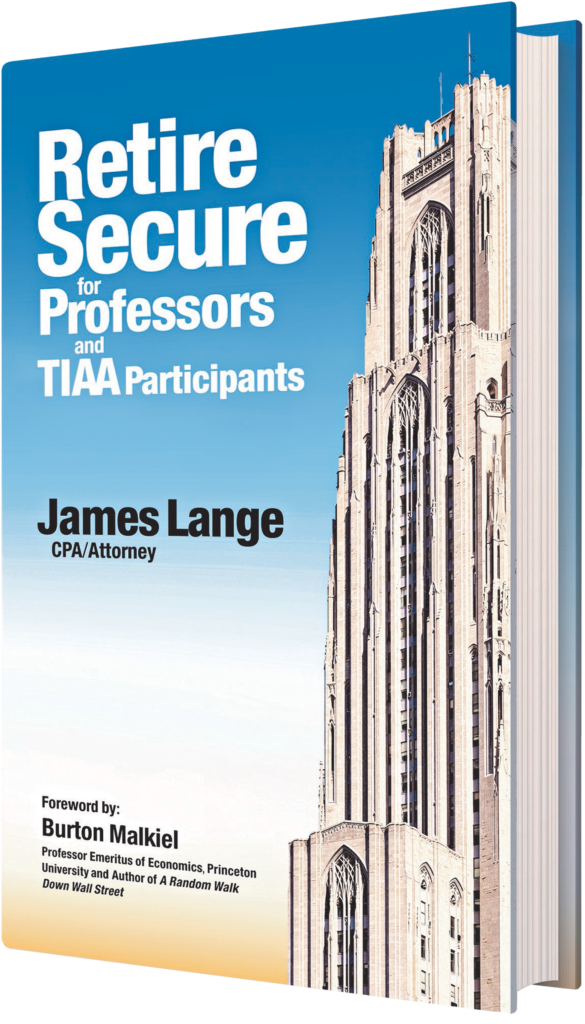How Professors and TIAA Participants Can...
Get the Most Out of What They’ve Got
Would You Like to Provide a FREE Workshop or Zoom Webinar for Your Professors and TIAA Participants?
by James Lange, CPA/Attorney
Our workshops offer exceptional financial strategies for professors and TIAA participants. But don’t take our word for it…
Retire Secure for Professors and TIAA Participants (October 2023) enjoys 71, out of 73, glowing five-star reviews on Amazon. The foreword is written by Burton G. Malkiel, Professor Emeritus of Economics, Princeton University, and renowned author of A Random Walk Down Wall Street, which sold 2 million copies.
The book guides professors and TIAA participants through the entire process of retirement and estate planning. It provides the most comprehensive information
available, including information expressly for professors and TIAA participants as well as critical information for most IRA
and retirement plan owners.
It is packed with data, analysis, graphs, and charts to persuasively assure readers that the information and recommendations have been fully researched and analyzed. The detailed Table of Contents offers readers a quick and easy way to locate information critical to their individual circumstances.
We have taken the most important information from the book and condensed it into two dynamic workshops for professors and TIAA participants. My primary objective is to help professors and TIAA participants ensure they have sufficient money to live comfortably after retirement and to optimize tax-advantaged transfers of wealth to their heirs.
My team at Lange Accounting Group, LLC and our affiliated companies have served 632 university faculty members, TIAA participants, retirees, and their families for more than 35 years. My mother and brother were professors. Of all my published books, Retire Secure for Professors and TIAA Participants is closest to my roots.
A Free Workshop for Your Audience
I am offering pro bono*workshops to universities, health care institutions, non-profits, and other organizations
to help professors and TIAA participants protect and maximize their retirement assets. In addition, I will be delighted to provide a hardcover book and corresponding educational workshop for all attendees.
I can customize the workshop for your particular audience and your time frame. The workshop will be packed with specific information on navigating the worlds of traditional TIAA, IRAs, and other retirement plans. I will address one of the greatest
mysteries of life—how to best withdraw your money from TIAA after retirement, information that could save your professors and TIAA participants and their families hundreds of thousands of dollars over time.
My workshops leave plenty of room for questions and answers. Attendees will walk away with a greater understanding of what it takes to retire securely and how to maximize their estate for their heirs. A description of two of my most popular workshops are outlined inside on pages 2 and 3.
Contact Us to Learn More!

Prepare yourself for the best retirement and estate planning information available.
I am ready to deliver cutting-edge strategies to members of your university or organization. I can customize my workshop to specifically cover the most crucial and informative topics for your membership. They will receive the best and most substantive retirement and estate planning advice and guidance on how to use these proven strategies to dramatically improve financial security.
Over the years, I have spoken to thousands of IRA and retirement plan owners, professors, physicians, financial advisors, accountants, and attorneys on proven tax-saving strategies—all 100% legal—that keep your wealth in your hands… and out of Uncle Sam’s.
For more information or to schedule Jim to speak for your university or organization, please call me, Jim Lange or Erika Hubbard at 1-800-387-1129 or email Erika@PayTaxesLater.com today!
*Please note: I offer these workshops in the true spirit of the meaning of “pro bono publica”—for the public good!

